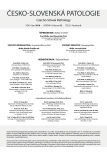Molecular genetics and determination of time since death – short communication
Authors:
Markéta Šaňková 1,2; Michaela Račanská 3
Authors‘ workplace:
Ústav soudního lékařství Lékařské fakulty Masarykovy univerzity a Fakultní nemocnice u sv. Anny, Brno
1; Laboratoř forenzní genetiky, spol. s r. o., Brno
2; Anatomický ústav Lékařské fakulty Masarykovy univerzity, Brno
3
Published in:
Soud Lék., 61, 2016, No. 3, p. 28-29
Category:
Short Communication
Overview
Estimation of time since death, i.e. the post-mortem interval (PMI), is one of the most problematic issues in forensic practice. Accurate determination of the PMI still remains very complicated task even for an experienced forensic pathologist.
Physical changes including algor, livor and rigor mortis can be observed already during the first hours after death of an individual. Unfortunately, the estimation of PMI on the basis of these changes is often burdened with a certain degree of inaccuracy, which is caused by the temperature of surrounding environment, constitution of the body, cause of the death, location of the body, drug abuse etc.
Accurate PMI estimation requires assessment of such parameters, which change constantly from the moment of death, but independently on ambient factors. According to current research in the field of molecular biology, it appears that a post-mortem degradation of nucleic acids (both DNA and RNA) will correspond to this definition.
Keywords:
post-mortem interval (PMI) – taphonomy – molecular genetics – DNA – RNA – nail – tooth
Sources
1. Hansen AJ, et al. Crosslinks rather than strand breaks determine access to ancient DNA sequences from frozen sediments. Genetics 2006; 173(2): 1175-1179.
2. Odriozola A, et al. MiRNA analysis in vitreous humor to determine the time of death: a proof-of-concept pilot study. Int J Legal Med 2013; 127: 573-578.
3. Higgins D, et al. Differential nuclear and mitochondrial DNA preservation in post-mortem teeth with implications for forensic and ancient DNA studies. PLoS ONE 2015; 10(5): 1-17.
Labels
Anatomical pathology Forensic medical examiner ToxicologyArticle was published in
Forensic Medicine

2016 Issue 3
Most read in this issue
- Molecular genetics and determination of time since death – short communication
- Intracardial fungal multiplication of order Mucor in an almost totally carbonised part of a male body found after ten days missing
- Alcohol-related deaths – a retrospective study from the region of northern Slovakia
